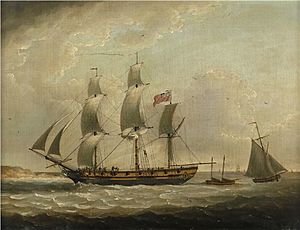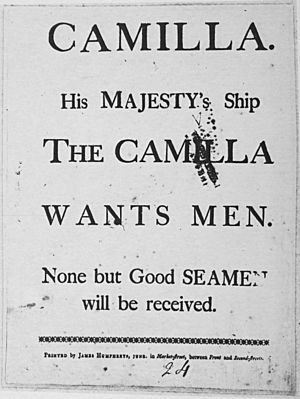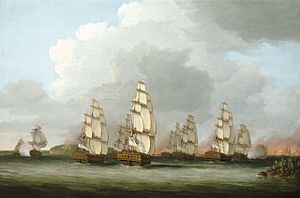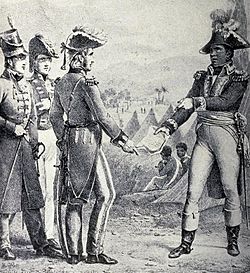HMS Camilla (1776) facts for kids

HMS Camilla, in 1796 by John Thomas Serres
|
|
Quick facts for kids History |
|
|---|---|
| Name | HMS Camilla |
| Ordered | 15 April 1773 |
| Builder | Chatham Dockyard |
| Laid down | May 1774 |
| Launched | 20 April 1776 |
| Completed | 9 July 1776 |
| Commissioned | May 1776 |
| Fate | Sold 1831 |
| General characteristics | |
| Class and type | Sphinx-class post ship |
| Tons burthen | 432 56⁄94 (bm) |
| Length |
|
| Beam | 30 ft 1 in (9.2 m) |
| Depth of hold | 9 ft 8 in (2.9 m) |
| Sail plan | Full-rigged ship |
| Complement | 140 (134 from 1794) |
| Armament |
|
HMS Camilla was a 20-gun ship in the Royal Navy, built in 1776. She was part of the Sphinx-class of ships. Camilla was built at Chatham Dockyard in England. She was designed by John Williams. This ship served in three major conflicts: the American Revolution, the French Revolutionary Wars, and the Napoleonic Wars. After a long career, she was sold in 1831.
Contents
HMS Camilla: American Revolution Adventures
Camilla began her service in May 1776. She sailed to North America in August of that year. Her first missions involved capturing ships that were not allowed to trade with Britain.
Early Captures and Encounters
Camilla captured a privateer schooner named Independence. This ship had six guns and 50 men. She was on a journey from Boston. Camilla also captured other ships carrying goods like molasses and coffee.
In January 1777, near Charleston, South Carolina, Camilla captured the American sloop Fanny. This ship was carrying molasses from Hispaniola. Soon after, Captain John Linzee took command of Camilla.
In February 1777, Camilla and Perseus captured a ship called Adventure. It was carrying fish and other supplies. Camilla had to fire eleven shots before Adventure stopped. Both British ships shared the prize money from this capture.
April 1777 was a very active month for Camilla.
- On April 6, she captured the brig Willing Maid. This ship was carrying sugar, rum, and salt. However, the brig started leaking and sank.
- On April 11, Camilla was with Roebuck near the Delaware River. They found an American merchant ship called Morris.
- The British ships fired at Morris, forcing her ashore. The Morris then exploded with great force. Reports said she was carrying 35 tons of gunpowder. It is believed the crew tried to blow her up, but something went wrong. Everyone on board died in the explosion.
Camilla captured several more ships in April. These ships were carrying rum, molasses, and sugar. She also captured Fonbonne, which was carrying wine and molasses. In July 1777, boats from Camilla and Pearl captured and burned the American schooner Mosquito.
Key Operations and Battles
When Philadelphia was taken by the British in 1777, American ships were trapped. The Americans sent fire ships towards the British fleet. However, gunfire from Roebuck, Camilla, and other ships made the Americans set their ships on fire too early. British boats then pulled the burning ships ashore, preventing any damage.
In February 1778, Captain John Collins took command of Camilla. She took part in operations at Newhaven and Penobscot. On May 29, 1779, Camilla was part of Admiral George Collier's group of ships. They sailed up the Hudson River and captured Stony Point. This was a key location. Camilla exchanged fire with Fort Lafayette during this time.
That summer, the British fleet moved north. Camilla was involved in Tryon's raid on New Haven, Connecticut in July.
Camilla also participated in the battle on August 13–14. In this battle, Collier's squadron destroyed the American Penobscot Expedition. Camilla shared in the prize money for capturing the American privateer Hunter.
Later that year, Camilla captured the brig Chance off Cape Cod. This ship was carrying salt. She also recaptured two other ships, Mackerel and Marquis of Rockingham. In December, Camilla sailed to Charleston, South Carolina. She was part of Vice Admiral Mariot Arbuthnot's squadron.
In spring 1780, Camilla, under Captain Charles Phipps, took part in the Siege of Charleston. The city surrendered on May 11. Camilla received prize money from the captured ships. In September, Camilla helped capture several more ships, including the brigs Wasp and Potomack. She also captured the schooner Henrico in November.
In April 1781, Camilla captured the sloop Ann. She then joined the Downs squadron. Captain J. Wainwright took command in November 1782. Camilla was taken out of service in March 1783.
Between the Big Wars
In March 1783, Commander John Hutt became captain of Camilla. He sailed her to Jamaica in May 1783. While in Jamaica, a small problem occurred on board Camilla. The ship returned to Britain in 1784. In December, she sailed for Jamaica again.
In September 1790, Camilla was reported to have brought the Duke of Sudermania from Finland to Sweden.
Fighting in the French Revolutionary Wars
In March 1794, Camilla was put back into service for the Downs station. In October 1795, Richard Dacres became her captain. Camilla was part of Richard Strachan's squadron in the English Channel.
On June 10, 1795, Camilla stopped two ships, Catherine and Eliza and Three Brothers. Both were sailing from Copenhagen. In February 1796, Camilla accidentally hit and sank a merchant ship called Unity off the Goodwin Sands. Unity was on a journey from South Shields to Lisbon.
Camilla shared in the prize money from capturing several ships with other Royal Navy vessels. These included Smuka Piga in April 1796 and Mary later that month. In December, Camilla and other ships captured Esperance.
On February 20, 1797, Camilla captured Heros. In March, Captain Stephen Poyntz replaced Dacres. In April, Camilla and other ships captured the American ship Favourite, which was carrying flour. In May, Camilla captured Jeanie.
When Robert Larkan took command of Camilla in September 1797, Richard Spencer joined the ship. Spencer later became a knight and a government official in Australia. On November 6, Camilla captured Marianne.
On May 4, 1799, Camilla arrived in Cap-Français, Haiti. She had the British General, Thomas Maitland, on board. He was there to offer support to General Toussaint Louverture.
In January 1800, Camilla captured three ships. On January 6, she took Jeune Aimie. Six days later, she captured Speculation. On January 29, off Le Havre, Camilla captured the French privateer lugger Vigoureaux. This ship had three guns and 26 men.
On March 15, Camilla left Portsmouth to escort a group of merchant ships to Newfoundland. Later that year, Camilla lost her mainmast in a storm. This happened while she was escorting ships from Newfoundland to Britain. Even though the storm scattered the ships, Camilla managed to escort six of them safely to Weymouth and Poole. In December 1801, Captain E. Brace took command, followed by Captain Henry Hill in 1802. Hill sailed Camilla to Newfoundland in July and returned in November.
Napoleonic Era Missions
Captain C. Woolaston briefly commanded Camilla. Then in April 1803, Captain Brydges Watkinson Taylor took over. In May, he sailed for Newfoundland.
On August 15, 1805, Camilla captured the French navy's brig-corvette Faune. This ship had 16 guns and 98 men. Camilla chased Faune for nine hours before capturing her. The Royal Navy later used Faune as HMS Fawn.
In December 1805, Captain Clotworthy Upton replaced Taylor. In March 1806, Captain J. Tower took command.
Between May 1807 and 1808, Camilla was in the Leeward Islands. Captain John Bowen had taken command in July 1806. On March 2, 1808, about 200 marines and sailors from Camilla and other ships landed on the island of Marie-Galante. The local militia quickly surrendered without any fighting.
Between July and August 1809, Camilla was one of many ships involved in the Walcheren Campaign. On November 3, Camilla, under temporary captain William Henry Dillon, met the Drie Gebroeders. This ship was sailing from Norway with timber. It also had wooden parts for gun-carriages, which were war materials. The captain of Drie Gebroeders said he was going to Britain, so Dillon let him go. However, after two hours, the ship was clearly heading towards the Dutch coast. Dillon caught up and seized the ship. The captain's explanation did not make sense, so the ship was sent to Britain as a prize.
Final Years of Service
Camilla was put into ordinary (meaning she was not in active service) at Sheerness in December 1809. She was then used as a floating breakwater. From 1814 to 1825, she served as a receiving ship. This meant she was used as a temporary home for sailors before they were assigned to other ships. After this, she was "laid aground for the protection of the waters."
Camilla was offered for sale on April 13, 1831. She was described as "Lying at Sheerness, Camilla, of 433 tons". She was sold on that day, ending her long service.




